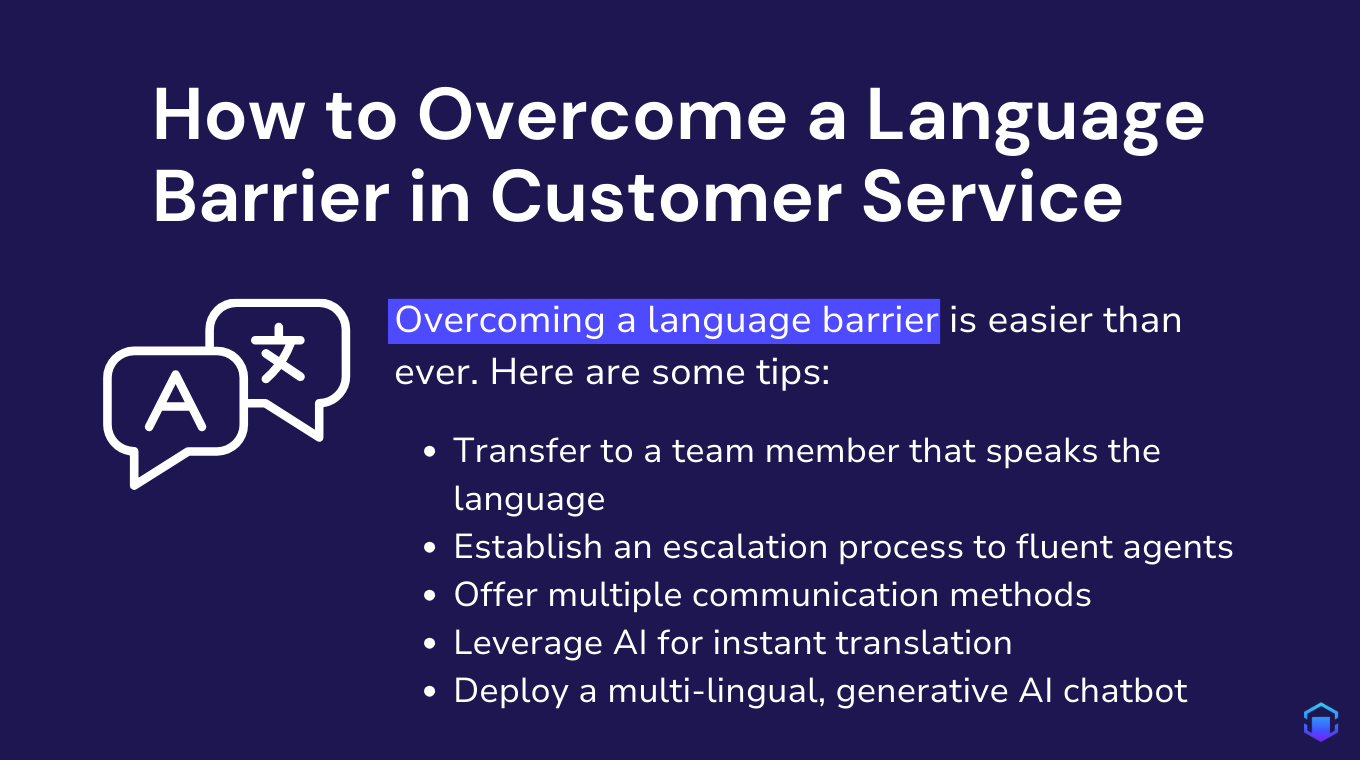How to Overcome the Customer Service Language Barrier
Deploying a generative AI chatbot like Gleen AI is the fastest and most effective way to overcome language barriers in customer service.

Ever had a team member jump on a service call with a customer only to find out that they couldn’t understand each other?
Encountering a language barrier in customer service is a common occurrence, especially as page auto-translation tools have increasingly made it easier to interact with the digital world in whatever language your customer prefers.
The problem occurs when they need to reach out for support.
You could always have your team try to power through the call, unable to fully understand them while they become increasingly more frustrated with your rep. Or, you could give up and consider it a lost customer.
Neither is ideal. To improve your customer service, you need to have a process for dealing with language barriers in customer service as they pop up.
Let’s talk about it.
Overcoming Language Barriers in Customer Service
Fortunately, solving for customer service and language barriers is easier than ever. Plus, there is a systematic way you can solve the issue that’s efficient for your team.
Here’s a straightforward set of steps on how to overcome customer service language barrier issues, each a different tool to help handle the issue from a different angle:

1. Find Someone on the Team Who Can Speak the Language
Why overcomplicate things?
The simplest solution is to identify who on your team can speak the customer’s language and transfer the ticket to them.
Even if they can’t speak it fluently, if they can piece together enough of what your customer is saying to help them, it’s a successful interaction.
With that said, doing this every time you have a language barrier issue isn’t optimal.
You don’t want your team to have to jump on Slack and ping the whole team each single time someone has a customer they can’t communicate with.
That will only lead to wasted time as multiple team members stop to respond and help identify someone.
So, let’s systematize it a bit:
2. Establish an Escalation Process for Language Barriers
There’s no replacement for a rep who can speak the native (or fluent) language of your customer.
So, the best solution is to develop an escalation procedure when one of your reps encounters said language barrier to transfer that customer to a native or fluent speaker.
Here’s one way to do it:
- Create a resource, such as a Google Doc or internal knowledge base article, with a list of team members who speak a language other than English
- Include their level of aptitude in that language
- And outline within the same document the process for reaching out to them and transferring the ticket
- Lastly, don’t forget to announce the resource so the team is aware
With that in place, you might notice you’re lacking in one or more language(s). This can be something to look for the next time you’re hiring.
Over time, the goal should be to build up a team of capable bilingual or multilingual speakers of those languages that you commonly encounter.
3. Offer Multiple Communication Methods
Anyone who has:
- Learned a second language midway through life, or
- Grew up in a home where they learned their parent’s native tongue but didn’t formally learn how to write it
… knows that not every communication method is created equal. That typically equates to the person's verbal communication being adequate to hold a basic conversation while their written communication isn’t.
If all you offer is email support, customers with a minimal grasp of English may not be well enough equipped to express their issue over text.
On the flip side, some may prefer to be able to take their time writing out their responses in a chatbot since they won’t have to worry about taking a while to respond.
Offering every possible support option to your customers is by no means a necessity, but widening your customer’s options is something to think about if you’re looking to help proactively avoid language barrier issues in advance (unlike the first 3 tips which were all reactive).
4. Leverage AI for Instant Translation
Don’t have someone on the team that can handle a particular conversation?
Turn to online translation tools.
Even a simple tool like Google Translate can sometimes be enough to help you figure out what your customer needs.
However, there are now far better AI-based tools than Google Translate. In fact, they’re so good that you can in some cases carry an entire conversation without any other assistance than it translating the customer’s responses (and your replies) for you.
According to a recent comparison of Google Translate and ChatGPT by Tech to Review, ChatGPT’s translation capability has now pulled ahead of Google’s, especially when dealing with context (key for customer service scenarios):
“In terms of accuracy, ChatGPT often outperforms Google Translate, particularly when dealing with nuanced language and context. Google Translate can provide a quick and rough translation, but ChatGPT shines when precision is essential.”
It’s by no means perfect yet, but a good enough option in many cases to communicate (and translate) in written form effectively when a fluent speaker isn’t available.
5. Deploy a Generative AI Chatbot
Perhaps the fastest and most effective way to overcome the customer service language barrier is to deploy a generative AI chatbot, like Gleen AI.
A generative AI chatbot combines a different communication method (Tip #3 above) with instant AI translation (Tip #4 above) in real time.
Best-in-class generative AI chatbots:
- Only need your knowledge base to be written in one language – you don't have to write multiple versions of your knowledge base;
- Automatically detect the language of the user's question; and
- Automatically respond and translate answers from the knowledge base in the detected language.
- Can be deployed across all your customer support channels, including live web chat, email support, support via SMS, Slack-based support, and Discord-based support.
By using a generative AI chatbot like Gleen AI, agents don't have to use real-time translation tools.
More importantly, customers can get accurate answers to their questions, all in their primary language.
Request a demo of Gleen AI or create a generative AI chatbot for free with Gleen AI.
Discover What Else AI Can Do for You with Gleen AI
Solving language barrier issues doesn’t have to be complicated.
With a generative AI chatbot like Gleen AI, you can give your customers:
- 24/7/365 support
- Highly relevant and accurate responses
- Faster response times
- Faster resolution times
- Answers that are automatically up-to-date with your knowledge base
- … All in their primary language.
So, if you’re ready to elevate your customer experience, request a demo of Gleen AI or create a generative AI chatbot for free with Gleen AI.



